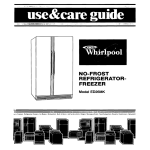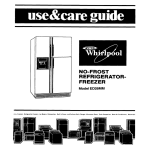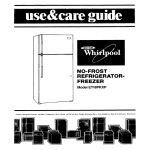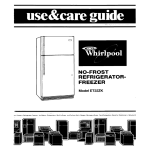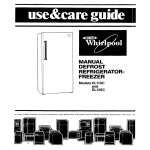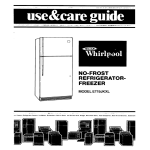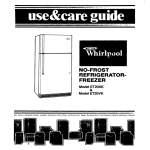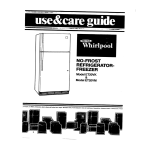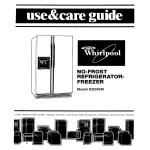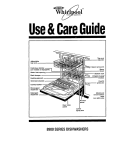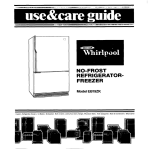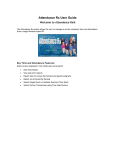Download Whirlpool EDISSC User's Manual
Transcript
/ NO-FROST REFRIGERATORFREEZER Model EDISSC is. Freezers. Relrlgerator-Freezers. Ice Makers. Dishwashers Eullt-In Ovens and Surface Un~ls. Ranges. Mtcrowave Ovens, Trash Compactors. Room Air Condllloners. Oehumldlfle Please read this Use and Care Guide before you do anything else... This booklet tells you how to start your refrigerator, clean it, move shelves and adjust controls. It even tells you what new sounds to expect from your refrigerator. Treat your new refrigerator with care. Use it only to do what home refrigerators are designed to do. Parts and features Ice Cube Trays Power Saving Control Control Freezer Shelves Meat Pan Cover Meat Pan Air Control . (not shown) Freezer Trivet ’ Copy your Model and Serial Numbers here... When you need service cf call with a questlon, have this Information ready: 1. Complete Model and Serial Numbers label located as shown). Model Number (from the Serial Number 1 2. Purchase date from sales slip Copy this information in these spaces. Keep this book, your warranty and sales slip together In a handy place I 2 Purchase Date Service Company and Telephone Number Contents SAFETYFIRST. BEFOREYOU PLUG IT IN. Changing the Light Bulbs Removing the Base Grille Ice Cube Trays Sounds You May Hear. Energy Saving Tips Install Properly Level Refrigerator-Freezer Remove Sales Labels Clean It Plug It In CLEANING YOUR REFRIGERATOR Cleaning Chart FOOD STORAGE GUIDE. USING YOUR REFRIGERATOR. Storing Fresh Food Freezing and Storing Frozen Foods Setting the Controls Changing the Control Settings Power Saving Control Adjusting the Refrigerator Shelves Removing the Freezer Shelves Adjusting the Meat Pan Temperature Removing the Meat Pan and Cover Removing the Freezer Trivet VACATION AND MOVING CARE IF YOU NEED SERVICE OR ASSISTANCE. I, 2. 3. 4. 01986 Whirlpool Before Calling for Assistance If You Need Assistance If You Need Service If You Have a Problem Page 7 7 7 7 8 8 9 10 10 11 14 15 15 15 15 15 Corporation Before you plug it in IMPORTANT Before using your refrigerator, you are personally responsible for making sure that it... l IS installed and leveled on a floor that will hold the weight, and in an area suitable for its size and use. l ISconnected only to the right kind of outlet, with the right electrical supply and grounding. [Refer to your “Electrical Requirements and Grounding Instructions.“) l is used only for jbbs expected of home refrigerators l l l l l l is not near an oven, radiator or other heat source. is properly maintalned. is out of the weather. is used in an area where the room temperature will not fall below 55” F (13” C) is not used by those who may not understand how It should be used is not loaded with food before it has time to get properly cold Install properly.. . Remove sales labels.. . Remove the Consumer Buy Guide label, tape and any inside labels before using the refrigerator. To remove any remaining glue: I. Rub briskly with thumb to make a ball then remove OR 2 Soak area with dishwashing detergent solution (1 teaspoon detergent in 1 quart warm water] before removing glue as described In step 1. DO ,NOT USE rubbing alcohol or flammable or toxic solvents, such as acetone, gasoline, carbon tetrachloride, etc. These can damage the material. NOTE: DO NOT REMOVE ANY PERMANENT INSTRUCTION LABELS INSIDE YOUR REFRIGERATOR. Do not remove the Tech Sheet fastened under the refrigerator at the front. ~. .a.=’ 1’41w4tmew.r* i:.w*, . * a.ti -?w‘r.L;*..+, / I .J?..,~‘.*...“.i, Clean it.. . Clean your refrrgerator before using it. See cleaning Instructions 1. Allow % inch (1.25 cm] space on each side and at the top of the refrigerator for ease of installation 2. If the refrigerator is to be against a wall, you might want to leave extra space so the door can be opened wider. 3. The refrigerator back can be flush against the wall , .. Plug it in... Level refrigerator-freezer... Levelli Refrigerator Power Cord RECOMMENDEDGROUNDING 1. Remove base grille [see page 7). 2. To raise front, turn each leg to the left. 3. To lower front, turn each leg to the rrght 4. Check wrth level METHOD A 115 Volt, 60 Hz., AC only 15 or 20 ampere fused and properly grounded electrical supply is required It is recommended that a separate circuit serving only this appliance be provided. Do not use an extension cord. Use a receptacle which cannot be turned off with a switch or pull chain. See Individual electrical requirements and groundrng ature package. instruction sheet in your liter- -8. c3 ,. -.m,i’rwma- Setting the controls.. . Give the refrigerator pletely before adding The Temperature Control is In the refrigerator and the Arr Control is tn the freezer section. When the refrigerator is plugged in for the first time. 5,@,’ era1 hours.] These settings should be about right for normal household refrigerator usage. The controls WIII be set about right when mtlk or juice IS as cold as you lrke and when ice cream 1sfirm. Do not block the air outlet on the control panel. Blocking It can slow the air movement needed to keep temperatures at the level you set. Jg5 3 I, Set the TEMPERATURE CONTROL to 3. 4 time to cool down comfood. (This may take sev- 2. Set the AIR CONTROL to 3 _. _ -_ ^ _--,. ~- _=_ - _ . Changing the control set&&s.. . If you need to adjust temperatures In the refrigerator or freezer, use the settings llsted In the chart below. CONDITION: If Refrigerator Section is TOO WARM If Freeze; Section is TOO WARM . ~*...L-Ae.s--, ’ QUESTIONS? .call your If Refrigerator COOL-LINE r/ Section is service TOO COLD assistance If ICE Isn’t telephone MADE FAST ENOUGH number @we 151. If BCj‘iH SECt10N37.‘ are TOO WARM l l l Adjust the Temperature Control first. Wait at least 24 hours between adjustments. Then adjust the Air Control, if needed. REASONS: RECOMMENDED SETTINGS: 4 Door opened often Temperature Control Large amount of food added Air Control 3 Room temperature too warm Temperature Control 3 Door opened often Air Control Large amount of food added 4 Very cold room temperature (can’t cycle often enough) -=,+. ‘~- )_,.._ %i_ _. ~~~rlY.~~<~C.I^ .I ,,. 1.. _e_u. 2 Controls notset correctly Temperature Control for vour conditions 3 Air Control 11m1-.-.‘ti.17.T,s. I.. .J.,,_ .. *a .a._I-.*-CliY9- . Heavy ice usage ’ Very cold room temperature [can’t cycle often enough) Door opened often Large amount of food added Very warm or very cold room temperatures >?. I LI ,I, _ ,,“.%U.L P -VT*=* .-s Temperature Air Control Control -.‘~ 3 4 Temperature Air Control Control 3 2 OFF Power Saving Control.. . o!el’ The Power Saving Control on the Control Console operates electrrc heaters around the door openings. These heaters help keep moisture from formrng on the outside of the refrigerator 1 Use the “OFF” setting when humidity is low. ,. ~. ., ..~ . . . . 2. Use the “0N”setting if moisture forms on the outsrde of the refrigerator. ..,, . . -. c,. r_-., _ ,,. r. 5 Adjusting the refrigerator Shelves can be adjusted your refrigerator. 1. Lift front slightly. 2. Lift back off supports. 3. Replace shelves... to match the way yo in reverse order. Lift the Front Then the Back Removing freezer shelves.. . 1. Loftfront slightly. 2. L1f-tback off supports. 3 Replace In reverse order. Adjusting Lltt the Front Then the Bat meat pan temperature.. . Cold air flows against the meat pan through an opening between the freezer and the refrigerator. This helps keep the meat pan colder than the rest of the refrigerator Set the control to let more or less cold air through. Use Control to Adjust Meat Pan Temperatures Removing the meat pan and cover... Removing Meat Pan: I, Slide meat pan straight out to stop 2. Lift the front. 3. Slide the rest of the way out. Removing Cover: Cover is held in place by two pegs at the back and a notched tab in front. I. Press front tab out of the way 2. Lift cover front. 3. Lift back off the pegs. 4. Replace in reverse order. l Removing the freezer trivet.. . I, Lift the trivet from the support brackets on the back wall. 2. Replace in reverse order. Snap Back Into Place. Changing the light bulbs... WARNING: Before removing a light shield for cleaning or for replacing the bulb either unplug refrigerator or disconnect electricity leading to refrigerator at the main power supply. Shock and injury can occur if electricity remains connected. Pull Off the Dial; Pull Out at the Bottom light bulbs behind refrigerator trol consoles: 1 2. 3. 4. 5 and freezer con- Pull control knob strarght off Pull bottom of control panel straight out. Lift top of panel off supports. Replace with a 40-watt appliance bulb Replace panel in reverse order. Removing the base grille... 1 Open the doors. To replace: 2 Pull grille outwards as shown 3 Do not removeTech sheet fastened behind grille 1. Line up grille support tabs with metal clips. 2. Push firmly to snap into place 3. Close the doors. Ice cube trays... If cubes are not used, they may shrink The moving cold air starts a slow evaporation. The longer cubes are stored, the smaller they get. To remove ice: 1 Hold tray at both ends 2. Slightly twist. Sounds you may hear.. . Your new refrigerator may make sounds that your old one didn’t Because the sounds are new to you. you might be concerned about them. Don’t be. Most of the new sounds are normal. Hard surfaces like the floor. walls and cabinets cmn make the sounds seem louder. The following chart descrtbes the kinds of sounds that might be new to you, and what may be making them. Possible Sounds: l l Probable Causes: Slight Hum, Soft Hiss: You may hear the refrigerator’s Clicking Sounds: The defrost timer makes a definite click when the refrigerator also makes a sound when the refrigerator starts. or Snapping fan motor and moving air stops running. It l Water Sounds: When the refrigerator stops running, you may hear gurgling in the tubing for a few minutes after it stops. You may also hear defrost water running into the defrost water pan. l Running Your refrigerator has a high-efficiency compressor and motor. It will run longer than older designs. It may even seem to run most of the time. Sounds: Energy saving tips... You can help your refrigerator use less electricity Check door gaskets for a tight seal. Level the cabinet to be sure of a good seal. l Clean the condenser coil regularly l Open the door as few times as possrble. Think about what you need before you open the door. Get everything out at one time. Keep foods organized so you won’t have to search for what you want Close door as soon as food is removed l Go ahead and fill up the refrigerator, but don’t overcrowd it so air movement is blocked. l l Cleaning your refrigerator Both the refrigerator and freezer sections defrost automatically. But both should be cleaned about once a month to help prevent odors from buildrng up. Of course, spills should be wiped up right away. To clean your refrigerator, turn the Temperature Control to OFF, unplug it, take out all removable parts, and clean it according to the following directions. l l It is a waste of electricity to set the refrigerator and freezer to temperatures colder than they need to be If ice cream is firm in the freezer and drinks are as cold as your family likes them, that’s cold enough. Keep the Power Saving Control on OFF unless moisture forms on the refrigerator exterior Make sure your refrigerator is not next to a heat source such as a range, water heater, furnace, radiator, or in direct sunlight. Cleaning chart... . Part I. -.. -* What to use How to clean Removable parts [shelves, crisper, etc ] Sponge or cloth; mild detergent and warm water l Outside-. Sponge. cloth or paper towel, mild detergent, appliance wax [or good auto paste wax]. . __ l l Wash removable parts with warm water and a mrld detergent. Rinse and dry Wash with warm water and a mild detergent Do not use abrasive or harsh cleansers. l l Rinse and dry Wax painted metal surfaces at least twice a year with appliance wax or a good auto paste wax. Apply wax with a clean, soft cloth. Do not use wax on plastic parts. ,, C.I _- .~,- cITII%IIz.II--I -I - Inside walls (Freezer should be allowed to warm up so cloth won’t stick.) , _, Waxing painted .-,- I. metal surfaces provides rust protection. Sponge, soft cloth or paper towel, baking soda, warm water, mrld detergent l l . . _ i_ ,li j, Wash with warm water and -mild detergent or -baking soda (2 tablespoons 1 quart [ 95 I] warm water. Rinse and dry (26 g ] to .,“._ Door liners and gaskets Sponge, soft cloth or paper towel; mild detergent, warm water. l l Wash with mild detergent water Rinse and dry and warm DO NOT USE Cleaning waxes, concentrated detergents, bleaches or cleansers containing petroleum on plastic parts. Defrost pan Sponge or cloth; mild detergent and warm water. l l l l l l l l Condenser Coil Vacuum cleaner: using the extended narrow attachment. l l l croor under refrigerator I Usual floor cleaners. l l l 1 l I / .. .~ Remove base grille. (See page 7.) To remove defrost pan, lift pan over wire brace [remove tape; if any). Wash defrost pan with warm water and mild detergent. Rinse and dry Replace with notched corner to the rear. Push it all the way in Make sure defrost drain tube is pointing into pan. Replace base grille. Remove base grille. Clean dust and lint from condenser least every other month. Replace base grille. Slide refrigerator out away from wall Wash floor Slide refrigerator into place. Check to see if the refrigerator is level. at Food storage guide STORING FRESH FOOD Cured or Smoked Meat and Cold Cuts. Ham, bacon. sausage, cold cuts, etc.. keep best In origrnal wrappings. Once opened, tightly re-wrap in plastic wrap or aluminum foil. Canned Ham. Store In refrigerator unless the label says it’s okay to store on the shelf. Do not freeze Fresh Pouitry...Wrap in plastic wrap. The plastic wrap on poultry, as purchased, may be used for storage. There IS a right way to package and store refrigerated or frozen foods. To keep foods fresher, longer. take the time to study these recommended steps. leafy vegetables., Remove store trim or tear off bruised and discolored cold water and drain Place in plastic container. Cold, moist air helps keep bles fresh and crisp. wrapping and areas. Wash in bag or plastic leafy vegeta- Vegetables with Skins (carrots, peppers)...Store in plastic bags or plastic container. Fruits...Wash, let dry and store in refrigerator in plastic bags. Do not wash or hull berries until they are ready to use. Sort and keep berries in their store conturner or in a loosely closed paper bag on a refrigerator shelf. STORAGE CHARTFORFRESHANDCUREDMEAT* Approximate lime TVPe (dwsl Variety Meats . . . . . . . . . . . . . . . . . . . . 1 to2 Chtcken . . . . . . . . . . . . . . . . . . . . . . . . . . 1 to2 Ground Beef . . . . . . . . . . . . . . . . . . . . . . 1 to 2 Steaks and Roasts . . . . . . . . . . . . . . . . 3 to 5 Cured Meats . . . . . . . . . . . . . . . . . . . . . 7 to10 Bacon . . . . . . . . . . . . . . . . . . . . . . . . . . . . 5to7 Cold Cuts . . . . . . . . . . . . . . . . . . . . . . . . 3 to 5 *If meat is to be stored longer than the times given. follow the directions for freezing. NOTE: Fresh fish and shellfish should be used the same day as purchased Eggs...Store Meat” Meat is perishable and expensive.. .you won’t want to waste an ounce of it through careless handling. The followrng list and chart grve you packaging hints and time limits. Store meat in the meat pan. Fresh, Prepackaged Meat. Store fresh meat in the store wrapping. Vacuum packaged meat can be frozen for as long as one month if the seal IS not broken. If you want to keep it frozen longer, you should wrap it with special freezer wrapping materral Fresh Meat, Not Prepackaged. Remove the market wrapping paper and re-wrap in aluminum foil for storing it unfrozen. Cooked Meat, Wrap or cover cooked meat with plastic wrap or aluminum foil. Store immediately 3 without washing in the original carton. Milk Wrpe mrlk cartons. For best storage, place mrlk on interior shelf or bottom door shelf. Beverages. Wipe bottles and cans. Store on a door shelf or inside the refrtgerator. Butter...Keep opened butter in covered dish on refrigerator shelf. When storing an extra supply, wrap in freezer packaging and freeze. Cheese .Store in the original wrapping until you are ready to use it. Once opened, re-wrap tightly in plastic wrap or aluminum foil. Condiments .Store small jars and bottles (catsup, mustard, jelly, olives] on the door shelves where they are in easy reach. leftovers ..Cover leftovers with plastic wrap or alumrnum for to keep food from drying out and transferring food odors. Plasttc containers with tight lids are fine, too FREEZING & STORING FROZEN The freezer sectron ISdesigned for storage of commercially frozen foods and for freezing foods at home. Packaging -The secret of successful freezing is in the packaging. The wrap you use must be air, moisture and vapor proof. The way you close and seal the package must not allow air, moisture or vapor in or out. Packaging done in any other way could cause food odor and taste transfer throughout the refrigerator and drying of frozen food. Rigid polyethylene [plastic] containers with tightfitting lids, straight-sided canning/freezing jars, heavy-duty aluminum foil, plastic-coated paper and non-permeable plastic wraps (such as Saran) are recommended. Note: Heat-sealed boiling bags are easy to use and can be used by themselves or as carton liners. Sealing- When sealing foods in bags squeeze out the air (liquids need headspace to allow for expansion,) Twrst the top and turn it back. Fasten tre securely around the doubled-over tail. Put the label inside transparent bags; use self-adhesive label on outside of opaque ones. Air-tight wrapping calls for “drugstore” wrap. Cut the sheet about one-third longer than the distance around the food Bring the ends together and fold In [toward the food) at least twice to seal out air. Crease ends close to food, press air from package. Fold tips over twice. Finish package and tape closed. NOTE’ With unboned meats, pad sharp edges wrth extra wrap or use stockinette to protect the wrap from punctures DO NOT USE: Bread wrappers l Non-polyethylene plastic containers l Containers wrthout tight lids l Waxed paper l Waxed-coated freezer wrap l Thin, semi-permeable wrap None of these are totally morsture, air or vapor proof The use ot these wrappings could l cause food odor and taste transfer and drying of frozen food. Freezing Fruits - Select ripe, blemish-free fruits Be sure they taste as good as they look. Wash 2 to 3 quarts (Inters) at a time and drain Fruit that stands in water may lose food value and become, soggy. Sort, peel, trim, prt and slice as needed. Pack in rigid wide-mouthed containers or other recommended material. Leave head space to allow liqujds to expand during freezing. Freezing Vegetables-Freeze only fresh highquality vegetables picked when barely mature. For best results, freeze no more than 2 to 3 hours after picking. Wash in cold water, sort and cut into appropriate sizes. Blanch or scald. Pack in recommended container and freeze. Do not freeze lettuce, celery, carrot sticks, potatoes or fresh tomatoes. All will become limp or mushy. Tomatoes will collapse when thawed. Freezing Cooked Food - Prepare cooked foods as you would for the table, shorten cooking time10 to15 minutes to allow for additional cooking during reheating Omit seasonings and part of the liquid. Plan to add them at reheating time. Potatoes should also be added to soup and stew at heating time Add crumb and cheese toppings at heating time. Cool as rapidly as possible and freeze at once Liquid or semi-liquid dashes may be frozen In recCasserommended containers with he&space oles and other more solid foods may be frozen in the baking container. If you don’t want to leave your casserole dish in the freezer. line It with foil. Bake, cool, freeze, lift out the foil package, bag it and return to freezer. Freezing Meats-The meat you thaw can only be as good as the meat you freeze. “Drugstore” wrap in meal-size packages. Flat cuts or patties should be wrapped individually or in layers separated by a double thickness of freezer wrap. Make sure store wrapprngs are moisture and vapor proof. If not, re-wrap meats with one of the wraps recommended under “Packaging” Freezing Baked Goods-Wrap baked breads in recommended material Thaw in wrapping. Unbaked yeast breads can be frozen after the first rising. Punch down, wrap and freeze. Bake cookies as usual Cool and freeze on trays, then pack in recommended freezer bags or cartons Unbaked cookies may be dropped, molded or rolled and frozen on cookie trays. Store In bag or carton; bake without thawing. Refrigerator-type cookies can be wrapped and frozen in roll form. Thaw only enough to slice when ready to bake Fruit pies are best frozen unbaked. Bake without thawing. Bake pecan and similar pies before freezrng .rich frllrngs do not freeze solid. Cut steam vents in top crusts when ready to bake IMPORTANT: Do not expect your freezer to quick-freeze any large quantity of food. Put no more unfrozen food into the freezer than will freeze within 24 hours. (No more than 2 to 3 pounds of fresh meat or 3 to 4 pounds of vegetables per cubic foot of freezer space.) leave enough space for air to circulate around packages. Be careful to leave enough room at the front so the door can close tightly. FOOOSTORAGECHART Storage times* will vary according to the quality of the food, the type of packaging or wrap used (moisture and vapor-proof). and the storage temperature which should be 0” F ( -17.8”c). Storage tlme Food FRUITS Fruit juice concentrate . . . . . 12 months Commercially frozen fruit . . 12 months Cltrus fruit and juices . . . . 4 to 6 months Others . . . . . . . . . . . . . . . . . 8 to12 months VEGETABLES Commercially frozen . . . . . . . 8 months Home frozen . . . . . . . . . . . 8 to12 months MEAT Bacon . . . . . . . . . . . . . . . . 4 weeks or less Corned beef . . . . . . . . . . . . . . . . . 2 weeks Cured ham . . . . . . . . . . . . . 1 to 2 months (Saltlng meat shortens freezer life) Frankfurters . . . . . . . . . . . . . . . . . . 1 month Ground beef, lamb, veal 2 to 3 months Roasts: Beef . . . . . . . . . . . . . . . . . 6 to 12 months lamb and veal . . . . . . . 6 to 9 months Pork . . . . . . . . . . . . . . . . . . . 4 to 8 months Sausage, fresh . . . . . . . . . . 1 to 2 months Steaks and chops: B-f . . . . . . . . . . . . . . . . . 8 to12 months lamb, veal, pork . . . . . . 3 to4 months FISH Cod, flounder, haddock Sole.. . . . . . . . . . . . . . . . . . . . . . 6 months Blue fish, salmon . . . . . . . . 2 to 3 months Mackerel, perch . . . . . . . . 2 to 3 months Breaded flsh (purchased) . . . 3 months Clams, oysters, cooked fish, crab, scallops . . . . 3 to4 months Alaskan klng crab . . . . . . . . . 10 months Shrlmp. uncooked . . . . . . . . . 12 months POULTRY Whole chlcken or turkey.. . . 12 months Duck . . . . . . . . . . . . . . . . . . . . . . . . 6 months Giblets . . . . . . . . . . . . . . . . . . 2 to 3 months Cooked poultry w/gravy . . . 6 months Slices (no gravy) . . . . . . . . . . . . . 1 month Food Storage tlme MAIN DISHES Stews; meat, poultry and fish casserole . . . . 2 to 3 months TV dinners , . . . . . . . . . . . . . . 3 to6 months DAIRY PRODUCTS Butter . . . . . . . . . . . . . . . . . . . 6 to 9 months Margarine . . . . . . . . . . . . . . 2 to 9 months Cheese: Camembert, brick, Mozzarella, farmer’s . . . . 3 months Creamed cottage . . DO NOT FREEZE Cheddar, Edam, Gouda, Swlss, etc.. . . . . . . . . . . . 6 to8 weeks Freezlng can change texture of cheese. Ice cream, Ice milk sherbet . . . . . . . . . . . . . . . . . . . . 4 weeks EGGS Whole (mlxed) . . . . . . . . . 9 to 12 months Whltes . . . . . . . . . . . . . . . . . 9 to 12 months Yolks . . . . . . . . . . . . . . . . . . . 9to12months [Add sugar or salt to yolks or whole mixed eggs) BAKED GOODS Yeast breads and rolls . . . . . . 3 months Baked Brown ‘N Serve rolls . . . . . . . . . . . , . . . . . . . . . . . 3 months Unbaked breads.. . . . . . . . . . . . -1 month Quick breads . . . . . . . . . . . 2 to 3 months Cakes, unfrosted . . . . . . . . 2 to 4 months Cakes, frosted . . . . . . . . . 8 to 12 months Fruft cakes . . . . . . . . . . . . . . . . . 12 months Cookie dough . . . . . . . . . . . . . . 3 months Baked cookies . . . . . . . . . 8 to 12 months Baked pies. . . . . . . . . . . . . . 1 to 2 months Pie dough only . . . . . . . . . . 4 to6 months *Based on U.S.D.A. and Michigan Cooperative suggested storage times. If electricity Extmsm Serv~ca goes off Call the power campany. Ask how long pow will be off. 1. If service IS to be interrupted 24 hours or less keep both doors dosed This WIII help froze1 foods to stay frozen. 2. If service IS to be Interrupted longer than 2, hours (a] Remove all frozen food and store In ( frozen food locker Or (b) Place 2 Ibs (0.9 kg] of dry ice in freezer fc every cu. ft. of freezer space. This will keel frozen foods for 2 to 4 days. Wear gloves t protect your hands from dry ice burns. (c] If neither food locker storage nor dry ice IS ovarloble, use or can perishable foot at once 3. A full freezer will stay cold longer than a port1 fllled one. A freezer full of meat will stay coI( longer than a freezer full of baked goods food contains ice crystals, it may be safe1 refrozen, although the quality and flavor ma be affected. Use refrozen foods quickly If tht condition of the food IS poor or you have an suspicions, it IS wise to dispose of It. Vacation :,,L.k:.’ and Short vacations. . . Moving. . . No need to shut off the refrigerator if You will be away for less than four weeks. Use up perrshables, freeze other items. Remove all food. Pack frozen foods in dry ice. Unplug the refrigerator and clean it thoroughly. Remove everything that comes out. Wrap all parts well and tape them together so they don’t shift and rattle. Screw in the levelling rollers; tape the doors shut; tape the electric cord to the cabinet. When you get to Your new home, put everything back, and refer to page 4. Long vacations. . . Remove all the food if You are going for a month or more. Unplug the refrigerator and clean it. .rinse well and dry. Tape rubber or wood blocks to both doors .-keeping them open far enough for air to get in This WIII keep odor and mold from building up. WARNING: Tape blocks out reach...do not allow the refrigerator when blocked open. They injured or trapped. of a child’s children near the doors are may become To restart refrigerator, see “Using Your Refrigerator.” 14 QUESTIONS? . ..call your COOL-LINE6 service assistance telephone number Owe 151. If you need service or assistance, we suggest you follow these four steps: 1. Before calling for assistance... Performance problems often result from little things you can find and fix Yourself without tools of any kind If your refrigerator will not operate: . Is the powersupply cord plugged into a live circuit with the proper voltage? (See page 4 ) l Have You checked Your home’s main fuses or circuit breaker box? l Is the Temperature Control turned ON? If there is a rattling or jingling noise, or other unfamiliar sounds: Is something on top or behrnd the refrigerator making noise when the refrigerator is running? New features on Your new refrrgerator make new sounds You may be hearing air flowing from the funs, timer clicks for the defrosting cycle, defrost water draining into the defrost pan. l l If there is water in the defrost pan: l In hot, muggy weather, this is normal. The pan can even be half full. Make sure the refrigerator is level so the pun doesn’t overflow 3. of you need service*... Whirlpool has a notionwide network of frunchrsed TECH-CARE’ Service Companies. TECH-CARE service technrcians are trained to fulfill the product warranty and provide after-warranty service, FRANCHISED SERVICE anywhere In the United I States. To locate TECHCARE servrce In Your area, cull our COOL-LINE sewice asslstance telephone number [see Step 2) or look In your telephone directory Yellow Pages under: 7EmvARE APPLIANCES-HOUSEHOLDMAJOR-SERVICE 6 REPAIR SERVICE XYZ SERVICE CO 123 Maple SERVICE XYZ SERVICE CO 123 Maple. See instructions for changing Use appliance bulbs only. 999-3393 COMPANIES 999.9999 WASHING MACHINES,DRYERS 8 IRONERSSERVICING WHIRLPOOL APPLIANCES FRANCHISED TECH-CARE SERVICE SERVICECOMPANIES XYZ SERVICE CO 999.9999 123 Maple light bulbs on page 7. If the motor seems to run too much: Is the condenser, behind the base grille, free of dust and lint? * On hot days, or if the room is warm, the motor naturally runs longer l If the door has been opened a lot, or if a large amount of food has been put in, the motor will run longer to cool down the interior. Remember: Motor running time depends on different things: number of door openings, amount of food stored, temperature of the room, setting of the controls And, youtnew refrigerator may be larger than Your old one so it has more space to be cooled. It also has a regular freezer instead of a frozen food compartment. All this means better refrigeration and may require more running time than Your old one l 2. If you need assistance*... Call Whirlpool COOL-LINE! service assistance telephone number. Dial free from: Continental U.S. . . . . . . . . . . . . . (800) 253-1301 Michigan . . . . . . . . . . . . . . . . . . . . (800) 632-2243 Alaska & Hawaii . . . . . . . . . . . . (800) 253-1121 and talk with one of our trained sultant can instruct you In how operation from Your appliance sary, recommend Q qualified Your Oreo. C0,MPA.k’IE.Y OR If a bulb is burned out: l APPLIANCESREPAIRING 6 PARTS WHIRLPOOL APPLIANCES FRANCHISED TECH-CARE SERVICE Have You checked Your home’s main fuses or circuit breaker box? Is the power supply cord plugged into a live circuit with the proper voltage? [See page 4 ) l ELECTAICAL MAJOR- WHIRLPOOL APPLIANCES FRANCHISED TECH-CARE SERVICE If the lights are not working: l OR 4. If you have a problem*... Cull our COOL-LINE sewice assrstance telephone number [see Step 2) and talk with one of our Consultants, or If You prefer, write to: Mr. Robert Stanley Division Vice President Whirlpool Corporation 2000 US-33, North Benton Harbor, Ml 49022 *If You must cull or write, please provide: model number, serial number, date of purchase. and a complete description of the problem. This informatlon is needed in order to better respond to Your request for assistance. FSP IS o registered 0 trademark of WhIrlpool Look for tnls svmbo’ of quality whenever you need o replacement part for Your WhIrlpool appliance FSP replocemenf parts ~111 fit right and work right. because they ore made to ihe some exacting speclf~col~ons used to build every new Whirlpool appliance Corporationforquollfy porls FSP @ Consultants The Conto obtain satrsfactory or, if sewice is necesservice company In 15 whirlpool Home ..A /Appliances Making your world a little easier. Part No. 1109131 01986 Whirlpool Corporation Printed in U.S.A. . ,. , _,.,. : Makers. DIshwashers BullI-In Ovens and Surface Units. Ranges. MIcrowave Ovens. Trash Compaclors, Room AH Condltloners. Oehumldlflers. Aulomatlc Washers, Clolhes Oryel
















